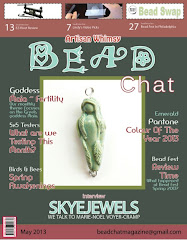This is the 5th in a series of posts devoted to breaking down the design process that went into each of my BSBP creations. The series so far:
- kumihimo lariat with gemstone chips
- sari ribbon and enameled bead necklace
- Vintaj charm/cha-cha bracelet
- sari ribbon cuff with bluebird
When we last left off, I had met the criteria for the Bead Soup Blog Party Challenge, having used both a clasp and focal sent by my partner. The reveal date was approaching rapidly, but Kate had sent me this red striped paper bag chock full of interesting stuff I never use, including wire solder and this cool copper "flat wire", which she told me she liked to use for ring shanks.
That stuck in my head, and I really wanted to try to solder a ring using this neat stuff, plus one of the huge purple iris Czech crystal beads she had sent.
Very coincidentally, this tutorial popped into my Pinterest feed one day about 3 weeks ago, and I hoarded it away, thinking it was a great fit for this ring idea I had.
On Tuesday of last week, I gathered the materials together, set up my iPad so I could follow along with the tutorial, and started making the wet manila paper insulation:
manila folders, a bowl of water, and the tutorial on my iPad
bowl of torn-up manila pieces, soaking
While the manila pieces were soaking, I set about to prep the shank:
flat copper wire
The first thing I did, as with most of my metal work, was create a paper template of the ring - allowing for size, shape, placement for the crystal, etc.
I finally got the paper model of the ring correct, with marks where I would bend the copper and drill holes for the crystal (a beadweaving needle holds the crystal in the paper ring)
Once I had the paper ring correct, I laid it on the copper and cut accordingly.
copper ring shank, with marks where I will bend and drill
Next, I drilled the holes, bent the shank, and filed all the rough edges:
ring shank, bend, drilled, and filed
All the easy stuff is done now - time to pull out the torch. This particular ring didn't require soldering, but I would be drawing a bead on each end of a piece of copper, to create a pin to hold the ring suspended at the top of the shank.
I used my acetylene torch, because it has a much finer flame than the MAPP torch I use for enameling.
I didn't get any shots of me drawing the first bead - pretty straight forward, as the ring itself isn't involved in this first torching.
Once I had a bead on one end of a piece of copper wire, it is time to draw the other bead. For this step, I would be placing the whole ring in a third hand (bead and all) and insulating the bead with the wet manila. In theory, the wet manila will keep the bead from getting too hot, without catching on fire.
ring, suspended in its manila insulation
When I drew the first bead, I measured how much copper wire I needed to flame to get the size ball I wanted on the wire - then after placing the pin in the shank with the bead in place, I measured and cut the copper wire extending from the other side so that I will (in theory) get the same size ball on the other side. That's the amount of copper wire you see hanging down in the pic above.
And then I aimed my flame at the copper wire, and this is what I got:
ring after firing
Instead of my copper ball beading up right next to the ring shank, it stopped, about 4 mm away.
10 times.
Yes, I kept repeating this step over and over, thinking I was doing something wrong. And I re-watched the tutorial. Several times. It always worked for the girl in the tutorial!
Yet no matter what I did, I kept getting the exact same result.
I held the flame on the wire/ring for a long time - so long that the manila paper was bone dry and smoldering. And no longer serving as insulation. Ultimately, since the bead seemed no worse for all that heat, I gave up on the manila altogether, and just pinned the ring to my firebrick and fired it - and got the same result. (that's the pic you see above) - I had thought that maybe my 3rd hand was drawing heat away from the copper wire I was trying to ball, so I switched to the stainless steel T-pins to hold the shank - but it made no difference.
Then I decided to do a test on some 24 gauge sheet copper:
It worked perfectly, right away. No prolonged heating - it just balled right up like a champ! Just like on the video.
At this point, I decided that the whole, thick, copper shank must be acting as a heat sink, drawing the needed head for the balling process away from the copper wire - so I went with plan B
I left the pin the way it was, and wrapped a very small amount of 28g orchid-colored artistic wire on either side of the shank to take up the slack - and that's what you see in the final result.
It was fun!



















2 comments:
That was a great step by step, thank you! I think I wil try this as a sort of bale.
Genius!!! I love this!
Post a Comment